Landscape design of a flower garden: stylish and beautiful solutions

An empty garden plot can be easily converted into a beautifully designed garden with a simple flower garden. Garden landscaping can be designed on your own without relying on the tastes of a designer who knows nothing about your preferences. And this is not as difficult as it seems at first glance.



Features and layout
There are many ways to translate your creative ideas into reality. Flowers can be planted in rows, combined with other plants or supplemented with decorative elements.
There are several main types of flower beds:
- Parterre... This word means a wide flower garden, which is located in the center of the site and attracts all attention. Most often, these flower beds are rectangular or square. Plants are planted on them in rows, combining contrasting shades.


- To decorate the territory, you can use discounts... These are neat rows of flowers that line the paths in the garden. Low flowers with neat buds are chosen for discounts.


- To decorate the entrance area, use tapeworms and bright flowers... They should be visible from afar in order to immediately draw attention to the entrance to the garden or to the territory of the site.
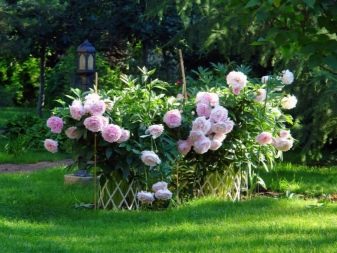

Choosing a style
The flower garden is decorated according to certain rules.
There are several of the most popular landscaping styles:
- French is considered one of the most charming. It originated in the 19th century and has been actively gaining popularity ever since. French-style flower gardens are neat, even and well-defined.



- Less thoughtful is the English style. It is chosen by those who love flowers, but do not want to spend all their free time on maintaining the flower garden in perfect order. The English style is a bit casual. Here it is permissible to combine flowers with wild plants and let them grow in all directions.


- You can also create a simple flower garden near a rustic or country house. A rustic-style flower bed can be located not only on the ground or next to the path. Flowers are often grown in unsuitable places for this purpose, such as a cart or barrel. It looks very picturesque and unusual, especially if the low flowers complement the graceful shoots of honeysuckle or ivy, descending to the ground.

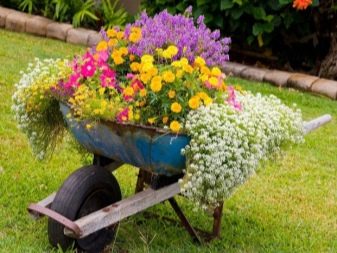
Where to equip a flower garden?
For a beautiful flower bed, you can find a place in any of the zones of your site.
Near the entrance
Just as a theater begins with a coat rack, a summer cottage begins with an entrance path. If a colorful flower garden is laid out in front of the entrance to the garden or to the plot, then everyone will immediately see that people live here who value beauty and know how to create beauty around them.


It is most correct for a flower bed at the entrance to pick up several central tall plants, several medium ones and a number of dwarf plants.
In the center of the composition there can be a lily or a rose, planted on all sides with evergreen thuja, sage, sedum and balsam.


Along the track
Garden paths can also be refined with flowers. This design does not require any special cash costs. For planting next to the path, it is recommended to use unpretentious perennial plants. For example, asters, cinquefoil, highlander or tenacious.


In the center of the garden
The central flower arrangement in the garden usually stands out from all other plants and becomes a real decoration of the area next to the house. In the center of the garden, you can place a beautiful sunny flower bed consisting of hibiscus, petunias and junipers. Or, on the contrary, to collect in one place all the brightest flowers, combining them together so that they form a rainbow circle.


Bright butterflies will become an additional "live" accessory for the flower garden in the center of the garden. They can be lured to a flower bed by picking the right flowers. Most of all these insects are attracted by such plants as echinacea, zinnia, sage.


By the gazebo
A small decorative flower garden looks great next to the gazebo. A round gazebo is easiest to decorate with flowers around the entire perimeter. And if it is rectangular or square, then you can plant flowers nearby in even squares of different colors. You can divide individual parts of this flower garden with the help of scrap materials - sand, sawdust or chalk.


Plant species
In addition to plants that exist in nature, there are a huge number of flowers bred by florists. This doubles the number of plants that can be used to decorate flower beds.
All of them have their own characteristics. Some are more refined in appearance, but less resistant to natural whims. Others, on the contrary, are able to survive both rains and frosts, but outwardly they hardly differ from wild plants. Both are suitable for decorating a flower garden.

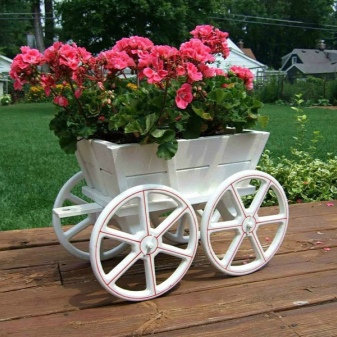
Perennial
For lazy gardeners, perennials are the most profitable find. They should be planted in early spring. Such plants bloom for almost three seasons in a row.
There are exquisite cushion perennials that weave on the ground. These include stachis, yaskolka, sagina, periwinkle and others. The main advantage of cushion flowers is that they hide the ground and serve as an excellent base for creating a vibrant flower garden.




Bulbous plants can also be perennial. For example, tulips, lilies or daffodils.
Having planted such a flower, you can admire its beauty for several more years in a row.



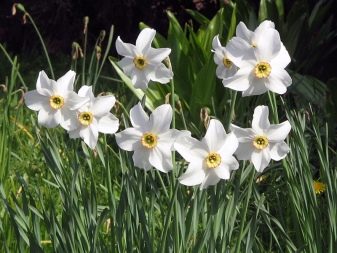
Annuals
Plants with a short lifespan are more capricious. Annual flowers will only decorate your flower garden for one season. They are planted in early summer, and after the plant has bloomed, its seeds are harvested so that the gardener can give it life next year.


How to choose flowers?
The most common shades of colors used in landscaping are red and orange. Green and silver can serve as a neutral base for the finished composition. Other colors are used to create accents and attract attention.


In addition to colors, there are other points to consider. The plants you choose should match in shape. It is also worth picking those flowers that bloom either at the same time or one after the other. This will make your flower garden look colorful and attract attention.


So that your efforts are not wasted, do not plant flowers affected by some kind of infection in a flower garden with healthy plants. It will infect other plants as well, making the flower bed quickly lose its attractiveness.
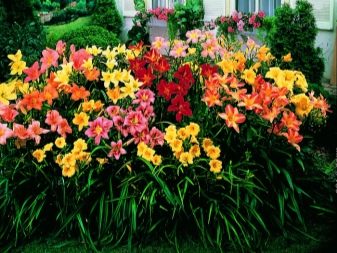

Keep in mind that all types of plants have their own wishes in terms of lighting and humidity. Flowers such as lilacs or thorns come to life in the shade. The penumbra is suitable for growing begonias, lilies and ferns. And tulips, daffodils or sunflowers love sunshine. If you plant the plants in a suitable place, they will bloom and smell, delighting you with their appearance.

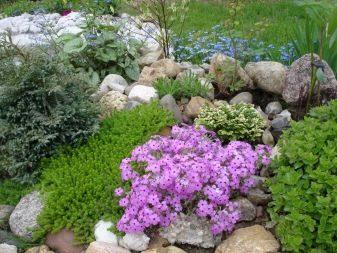
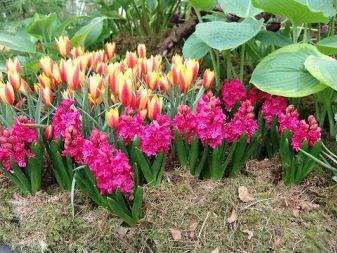

Tips for creating
If this is your first time creating a flower garden with your own hands, then you should not experiment by planting seeds in a chaotic manner. Think in advance how you want to see it, and, if possible, even sketch the project on paper. This sketch will be a reference point that will allow you to calculate both the number of seeds and the location of the flowers.


It is worth calculating the time of planting flowers. Calculate everything so that the plants bloom according to the seasons, and there are no months when the flower bed is empty. This is not so difficult to do, because there are many types of plants that bloom at different times of the year.
And when all the plants are planted and the time has come for their active flowering, do not be discouraged if something went wrong. The reasons for this may be different: some flowers fully demonstrate their beauty, only after a few years, others are afraid of rain or drought. Even if the flower garden in a private courtyard is not perfectly decorated, it doesn’t matter.


Care features
Planting plants according to your sketches is not enough.
The flower garden must be constantly looked after, maintaining its neat and lively appearance:
- For plants to bloom and smell, the soil needs to be fertilized regularly. To do this, the easiest way is to use manure diluted with water in a ratio of 1: 3. A more concentrated solution will harm the flowers. As an alternative to manure, you can use nitrogen or phosphorus fertilizers, which can be purchased at almost every gardening store. Simple ash is also suitable as a fertilizer.


- Also, of course, do not forget about regular watering and weeding of the flower garden. Without enough water, the plants will dry out, and if they are not weeded, the weeds will clog the flower bed.



It is not so difficult to decorate a beautiful flower garden. You do not need to have a professional education or special skills for this. A well-developed taste and desire to decorate your site is enough, and the rest will come with practice. And in a few years, flower beds in your suburban area will look no worse than the alpine slides created by professionals.
For information on how to break a beautiful flower garden, see the next video.







































































































The comment was sent successfully.